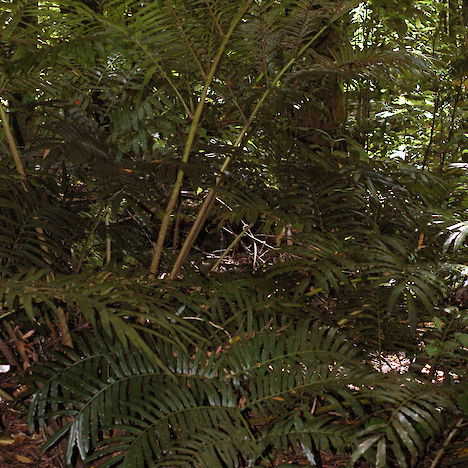Other names:
Marattia salicinaThreat category:
At Risk: Declining?Regions:
Northland, Auckland, Waikato, Bay of Plenty, Manawatu-Wanganui, TaranakiDistribution:
Western and northern North Island
Many of New Zealand’s threatened ferns are found in warmer climates on landmasses north of New Zealand, with New Zealand representing their southern distribution limits. These species tend to be restricted to northern areas of the country and occupy coastal and geothermal sites. Other species are restricted to habitats such as wetlands, which have suffered drastic modification and loss, or are palatable to stock and feral animals.
Key Features
- Previously known as Marattia salicina.
- Large, terrestrial fern with broad, dark green, glossy fronds arising in a rosette from a thick, hardened base. Fronds are very large, up to 4 m long and 2 m wide. Sporangia occur in two rows near the leaflet margins and are fused into groups which open lengthwise by slits. King fern has a starchy rhizome which was an important food source for Maori, and is attractive to pigs.
Distribution and Habitat
- Originally found from Taranaki and the Bay of Plenty northwards, but is now restricted to scattered populations in Auckland, Coromandel and the Waikato. Occurs in heavy bush in shady gullies in lowland forest.
Threats
- Habitat modification and loss.
- Grazing by stock and feral animals.
- Uprooting by pigs.
Management Opportunities and Methods
- Survey for new locations.
- Protection of habitat.
- Exclude stock.
- Control of feral animals, especially pigs.
Monitoring Options
- Check existing populations annually.
- Report new locations to DOC, NZPCN.
Further Information and Support
- New Zealand Plant Conservation Network (NZPCN). http://www.nzpcn.org.nz
- Pest animal management - Department of Conservation, Regional Councils.
- References
- Brownsey, P.J. & Smith-Dodsworth, J.C. (2000). New Zealand Ferns and Allied Plants. David Bateman, Auckland.


